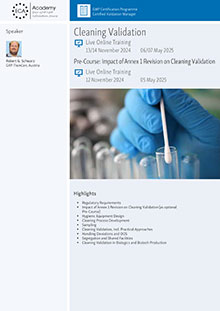ECA VALIDATION GOOD PRACTICE GUIDE: A VALUABLE SOURCE OF INFORMATION
It has been very quiet around process validation in the recent years. Only the FDA initiative "cGMP for the 21st Century" got things moving again. Then, in January 2008, the US authority issued the draft of the "Guidance for Industry, Process Validation: General Principles and Practices". This draft already indicated that there would be tremendous changes. Today, five years later, it is safe say that no other area experienced that many innovations in the past years as process validation (incl. qualification).
Validation is now seen as a life cycle concept with a three-step approach (process design, process qualification and continuous process verification). The issue is thus no longer to complete three validation runs. It is much more the evidence of process knowledge and understanding. Embedded in this life cycle is also the system qualification. An ISPE White Paper from 2005 showed where the journey is supposed to go in terms of a modern qualification. The ASTM document E 2500-07 implemented this White Paper. With its process validation guidance draft as well as with a Concept Paper for the revision of the Annex 15 the EU "picked up the ball and passed it on". They now also refer to a validation life cycle concept.
Now the ball is with the industry - and with the authorities - to implement these new theoretical approaches. For this purpose the ECA "Good Practice Guide on Validation" is a valuable source of information. On 136 pages the Guide describes the new requirements ("what to do") and their implementation ("how to do"). The first part is comprised of a historical introduction into the subject of validation (incl. qualification) and a description of the current developments. This part is followed by a comprehensive "how to do" section, starting with an article on the issue risk-based process validation. This article first introduces possible risk analysis tools. Based on an example granulation it then partly demonstrates the implementation of a FMEA risk analysis.

Recommendation
Wednesday, 7 May 2025 9 .00 - 12.30 h
Post-Course: Impact of Annex 1 Revision on Cleaning Validation - Live Online Training
The article "risk-based qualification" also concentrates on a risk-based approach and introduces what the way from the classical DQ/IQ/OQ/PQ concept to a much more flexible and lower-cost science and risk-based approach according to ASTM E2500 could look like. Based on a blister process example a further article on "Statistics in Process Validation and Continuous Process Verification" finally shows how "old" (3-batches validation) and "new" (statistical view) validation approach can be brought together (see also figure 1).

Figure1: How to align the „3 batch evaluation“ and „continuous validation“
Referring to biotechnological processes the Guide also illustrates in detail how a modern process validation and a statistical trending look today. Here, key to success are the demonstration of CpK values and a statistic process control (SPC).
One of the most important questions throughout the development towards a validation life cycle is certainly how "old processes" are to be handled. This question is covered in a special contribution. The Guide further provides complemental support relative to Manufacturing Excellence. In four Annexes it also introduces survey results with regard to ways of implementation from the pharmaceutical industry's perspective, compares the FDA draft Guide with the finalised version and interprets the EMA draft of the process validation guidance.

Recommendation
5/6 May 2025
Cleaning Validation - Live Online Training
Conclusion
The ECA "Good Practice Guide on Validation" provides both the pharmaceutical, the API industry and authorities with suggestions and support for the implementation for a modern validation and qualification concept.Author:
Sven Pommeranz
CONCEPT HEIDELBERG



